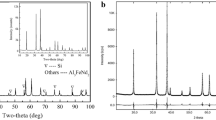Abstract
We conducted powder neutron diffraction for δ-AlOOH samples with and without Mg and Si ions under ambient conditions in order to investigate the long-standing problem of the symmetry of this phase. The observed reflection conditions clearly show that the space group of pure δ-AlOOH is P21 nm with ordered hydrogen bonds, whereas that of δ-(Al0.86Mg0.07Si0.07)OOH is Pnnm or Pnn2 with disordered hydrogen bonds. It is more likely that the space group of δ-(Al0.86Mg0.07Si0.07)OOH is Pnnm, because cation or hydrogen ordering that breaks the mirror plane perpendicular to c axis in the Pnnm structure would not occur. The previously reported inconsistency for the space group of this phase was caused by the substitution of Mg and Si ions to Al site, i.e., the disordered cations with different valences may fluctuate hydrogen positions, and the disordered hydrogen causes the symmetry change.



Similar content being viewed by others
References
Benoit M, Marx D (2005) The shapes of protons in hydrogen bonds depends on the bond length. Chem Phys Chem 6:1738–1741
Brown ID (2009) Recent developments in the methods and applications of the bond valence model. Chem Rev 109:6858–6919
Fujihara T, Ichikawa M, Gustafsson T, Olovsson I, Tsuchida T (2002) Powder-neutron diffraction studies of geometric isotope and hydrogen-bonding effects in β-CrOOH. J Phys Chem Solids 63:309–315
Ichikawa M (2000) Hydrogen-bond geometry and its isotope effect in crystals with OHO bonds–revised. J Mol Struct 552:63–70
Komatsu K, Kuribayashi T, Sano A, Ohtani E, Kudoh Y (2006) Redetermination of the high-pressure modification of AlOOH from single-crystal synchrotron data. Acta Crystallogr E62:i216–i218
Kudoh Y, Kuribayashi T, Suzuki A, Ohtani E, Kamada T (2004) Space group and hydrogen sites of δ-AlOOH and implications for a hypothetical high-pressure form of Mg(OH)2. Phys Chem Minerals 31:360–364
Larson AC, Von Dreele RB (2004) General structure analysis system (GSAS). Los Alamos National Laboratory Report LAUR, 86–748
Li S, Ahuja R, Johansson B (2006) The elastic and optical properties of the high-pressure hydrous phase δ-AlOOH. Solid State Commun 137:101–106
Matsui M, Komatsu K, Ikeda E, Sano-Furukawa A, Gotou H, Yagi T (2011) The crystal structure of δ-Al(OH)3: neutron diffraction measurements and ab initio calculations. Am Mineral 96:854–859
Momma K, Izumi F (2008) VESTA: a three-dimensional visualization system for electronic and structural analysis. J Appl Crystallogr 41:653–658
Moritomo Y, Tokura Y, Takahashi H, Mōri N (1991) Quantum paraelectricity and subsequent disappearance of bond alternation of molecule caused by proton dynamics in squaric acid crystal. Phys Rev Lett 67:2041–2044
Nelmes RJ (1988) On the structural evidence for a direct proton tunnelling effect in the KH2PO4-type transition. J Phys C Solid State Phys 21:L881–L886
Ohtani E, Litasov K, Suzuki A, Kondo T (2001) Stability field of new hydrous phase, δ-AlOOH, with implications for water transport into the deep mantle. Geophys Res Lett 28:3991–3993
Panero WR, Stixrude LP (2004) Hydrogen incorporation in stishovite at high pressure and symmetric hydrogen bonding in δ-AlOOH. Earth Planet Sci Lett 221:421–431
Sano A, Ohtani E, Kubo T, Funakoshi K (2004) In situ X-ray observation of decomposition of hydrous aluminum silicate AlSiO3OH and aluminum oxide hydroxide δ-AlOOH at high pressure and temperature. J Phy Chem Solids 65:1547–1554
Sano A, Ohtani E, Kondo T, Hirao N, Sakai T, Sata N, Ohishi Y, Kikegawa T (2008) Aluminous hydrous mineral δ-AlOOH as a carrier of hydrogen into the core-mantle boundary. Geophys Res Lett 35:L03303
Sano-Furukawa A, Komatsu K, Vanpeteghem CB, Ohtani E (2008) Neutron diffraction study of δ-AlOOD at high pressure and its implication for symmetrization of the hydrogen bond. Am Mineral 93:1558–1567
Sano-Furukawa A, Kagi H, Nagai T, Nakano S, Fukura S, Ushijima D, Iizuka R, Ohtani E, Yagi T (2009) Change in compressibility of δ-AlOOH and δ-AlOOD at high pressure: a study of isotope effect and hydrogen-bond symmetrization. Am Mineral 94:1255–1261
Suzuki A, Ohtani E, Kamada T (2000) A new hydrous phase δ-AlOOH synthesized at 21 GPa and 1000°C. Phys Chem Minerals 27:689–693
Tsuchiya J, Tsuchiya T (2009) Elastic properties of δ-AlOOH under pressure: first principles investigation. Phys Earth Planet Inter 174:122–127
Tsuchiya J, Tsuchiya T, Tsuneyuki S, Yamanaka T (2002) First principles calculation of a high-pressure hydrous phase, δ-AlOOH. Geophys Res Lett 29:1909
Tsuchiya J, Tsuchiya T, Wentzcovitch RM (2008) Vibrational properties of δ-AlOOH under pressure. Am Mineral 93:477–482
Vanpeteghem CB, Sano A, Komatsu K, Ohtani E, Suzuki A (2007) Neutron diffraction study of aluminous hydroxide δ-AlOOD. Phys Chem Minerals 34:657–661
Acknowledgments
We thank Dr. Thomas C. Hansen and Dr. John S. Loveday for their help with the neutron diffraction experiments, and Dr. A. Shimojuku for sample syntheses. Prof. E. Ohtani provided access to the Kawai-type high-pressure apparatus at Tohoku University. We also thank Prof. Y. Kudoh for providing information on his study and for fruitful discussions. Figure 1 was drawn by the VESTA program (Momma and Izumi 2008). This study was financially supported by a Grant-in-Aid for Creative Scientific Research entitled ‘Material sciences at ultra-high pressure using the strongest spallation neutron source’ (19GS0205) and also supported by a Global COE program from a Grant-in-Aid for Scientific Research from the Ministry of Education, Culture, Sports, Science and Technology (MEXT) and MEXT Grant No. 21840024 to KK.
Author information
Authors and Affiliations
Corresponding author
Rights and permissions
About this article
Cite this article
Komatsu, K., Sano-Furukawa, A. & Kagi, H. Effects of Mg and Si ions on the symmetry of δ-AlOOH. Phys Chem Minerals 38, 727–733 (2011). https://doi.org/10.1007/s00269-011-0445-0
Received:
Accepted:
Published:
Issue Date:
DOI: https://doi.org/10.1007/s00269-011-0445-0




